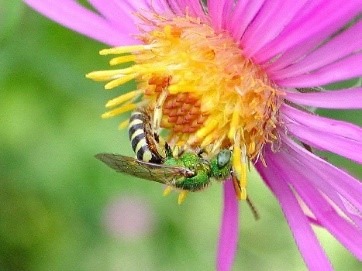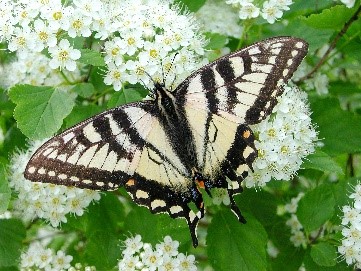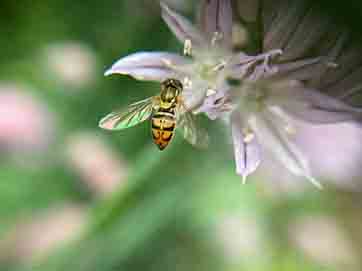Agriculture and Agri-Food Canada's (AAFC) wealth of agricultural research supports farmers and food processors as they put food on Canadian tables. As more Canadians take to their gardens and social distance during the COVID-19 period, we are sharing a series of gardening tips based on our research. If you missed the first two sets of tips, about soil preparation and managing pests, check them out at Agri-info.
By midsummer, your garden will be full of life and you may even be harvesting early bunches of produce like lettuce, radishes, and herbs. Slower growing vegetable plants like tomatoes, cucumbers, and squash have been blooming, showing off bright flowers to attract pollinators.
While bumble bees are probably the most recognized pollinator, there are many other pollinators hard at work on farms and in your garden including native bees, butterflies, beetles, flies, and even some wasps. Plus, don't forget the night shift —moths and bats are pollinators, too.
Learn how to support your local pollinators with help from our researchers!
Native bees

Image credit: Henri Goulet.
Bees deserve their reputation as they are the most important wild pollinators in the insect world. There are more than 20,000 bee species worldwide and nearly 970 native bee species in Canada. They play a vital role in Canadian agriculture by pollinating canola and blueberry crops and helping to maintain bushes and shrubs.
Many native bees are solitary, meaning they don't live in hives. Most live in underground burrows or other natural cavities, and fly less than a kilometre from their homes. They're mostly non-aggressive and many are stingless. Look out for bees of a different colour, too. Fun fact: Toronto's official bee, Agapostemon virescens, part of the sweat bee family, has a bright metallic green head and thorax.
Boost the bees!
Encourage native bees to live near you by planting bee-friendly flowers, having exposed soil for them to burrow in, and/or building an insect hotel —a collection of hollow stems, reeds, or branches. Switch from mulch to compost and only till if necessary as grass lawns, paved surfaces, and thick layers of mulch limit the nesting habitat of bees.
Butterflies

Image credit - Henri Goulet.
Butterflies are significant pollinators, especially of vegetable and herb crops. In fact, butterflies are the primary pollinator for plants in the carrot family (dill, celery, cilantro), brassica family (broccoli, kale, cabbage), mint family (oregano, rosemary, thyme, lavender), and legumes (beans, peas). Swallowtail butterflies, so-called because their back wings have ends that look like the tails of swallows, like ash, birch, magnolia, and willow trees.
Butter-up the butterflies!
Add more host plants. Some butterflies and moths look for specific host plants so they can lay their eggs. Attract butterflies with plants that have flat open flowers or clumps of small flowers they can use as a landing surface. Tree leaves are also good landing spots for butterflies.
If you're looking to attract monarchs, you'll have to plant milkweed as it's the only host plant the orange and black beauties like.
Beetles

Image credit - Henri Goulet.
Did you know that one in five of all known life forms on earth is a beetle? While some beetles are considered garden pests, many others are allies — and pollinators.
With a history dating back 200 million years, beetles were working as pollinators before bees even existed. As such, beetles pollinate some of the earth's most ancient plants, like magnolias.
Beetles benefit farms and gardens in other ways, as well. They recycle soil nutrients, eat live and dead plant and animal tissue, help control weeds, and eat insect pests like aphids, slugs, and caterpillars. Their hard work leads to healthier soil, and less competition for resources like light, nutrients and water.
Better beetles!
Pollinating beetles are attracted to strong spicy or sweet smells, like crabapples.
Flies

Image credit - Roselyne Labbé
Flies are important pollinators, especially in cooler northern climates unsuitable to bees. Some flies, called bee flies, even look like bees, buzzing around with fuzzy yellow and black striped bodies.
Hoverflies, from the family Syrphidae, are the most common pollinating fly.
Flies play another important role in the garden —about 40 percent of hoverflies start life as larvae that prey on other insects, like damaging aphids.
Fostering flies!
Hoverflies, also called flower flies, pollinate a variety of fruit crops, and like apples, pears, cherries, plums, apricots, peaches, strawberries, raspberries, and blackberries.
Wasps

Image credit - Henri Goulet.
Wasps are minor pollinators. Compared to fuzzy bees, their bodies are too smooth and their legs lack the hairs to which pollen sticks. But, that doesn't make them less important in your garden.
In addition to their limited pollination work, wasps are beneficial because they keep other insect populations in balance. Farmers consider wasps biological control agents —a natural way to control bad bugs, like midges, without using chemical insecticides.
Nocturnal pollinators

Image credit - Shona Milne.
Moths and bats do more pollinating than you might think. Like bees, they have fuzzy bodies that are perfect for transporting pollen, they fly further to cover more territory than bees, and they work at night when other pollinators don't.
Nurture the night!
Pollinating moths are attracted to night time flowers, which are often white, so they stand out in the dark. Bats are attracted to evening primrose, four o'clocks, night-blooming jessamine, and honeysuckle.
While enjoying your garden this year, keep our pollinators in mind and support them whenever you can.
Check out our researchers' "I Spy – Pollinators" (PDF) game to track your garden allies.
Get more Agri-info
- Want more stories like this? Explore what else Agri-info has to offer.
- Interested in reporting on this story? Contact AAFC Media Relations at aafc.mediarelations-relationsmedias.aac@agr.gc.ca to arrange an interview with one of our experts.